Connect and Manage a Cluster
Mia-Platform Console allows authorized users to manage the Kubernetes clusters on which projects are deployed. More specifically, a user can:
- Add a new connection to an existing Kubernetes cluster, also including some cluster information such as vendor, distribution, or geographics;
- Edit the connection to an existing Kubernetes cluster, and eventually the cluster information;
- Delete the connection to an existing Kubernetes cluster.
It is essential to point out that these operations do not have an impact on the original Kubernetes cluster, but only on the connection to the cluster itself,as they are meant to provide the user with information about it. Therefore, as an example, adding a new cluster connection does not generate a new cluster, but simply links an existing one to the Console.
The clusters management can be done at the Company level, through the "Clusters" section.
Here you can see a table containing some information about the clusters connected to the Console:
- Cluster ID: friendly identifier of the cluster, assigned by the user while connecting the cluster to the Console;
- Kubernetes version: Git version of the Kubernetes master node associated with the cluster;
- Cluster URL: URL used to connect to the cluster, which indicates where the cluster is exposed;
- Vendor: a label used to describe the vendor of the cluster (e.g. Google, AWS...);
- Runtime service: a label used to describe the runtime service of the cluster (e.g. WMWare Tanzu, GKE).

Connect a Cluster
You can connect a cluster by clicking on the "Add cluster connection" button, located in the page's top right corner. A modal will show up, and, through a few steps, you will be asked to enter some information related to the cluster.
Step 1: Runtime Service
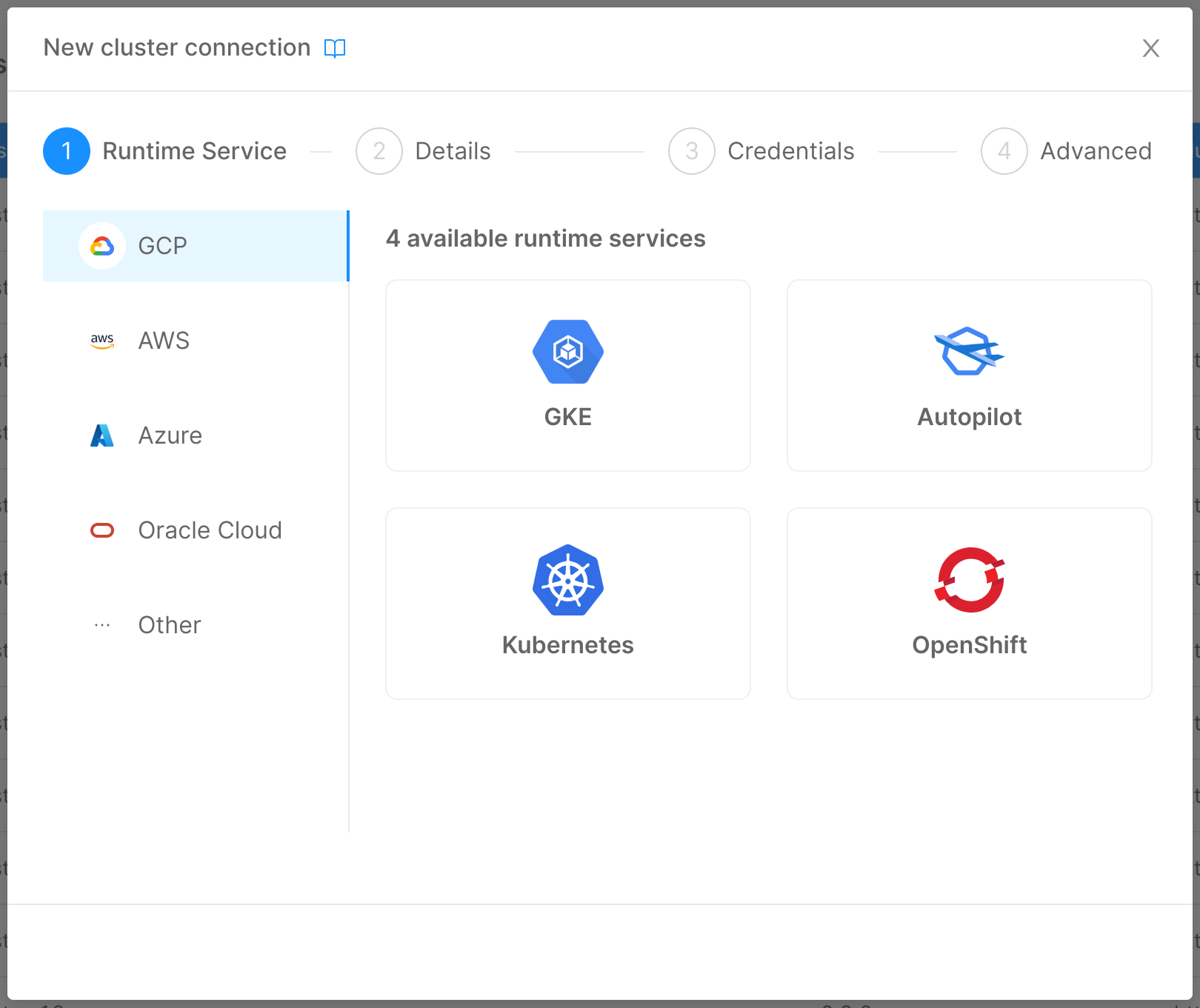
In this step, you are required to choose the cluster's vendor and runtime service. You can do so by selecting a vendor tab and clicking on the card related to the runtime service you want to use. Further information on the supported vendors and runtime services can be found here.
In case your vendor is not supported by the Console, don't worry! You can still select the "Other" tab and choose a runtime service.
Step 2: Details
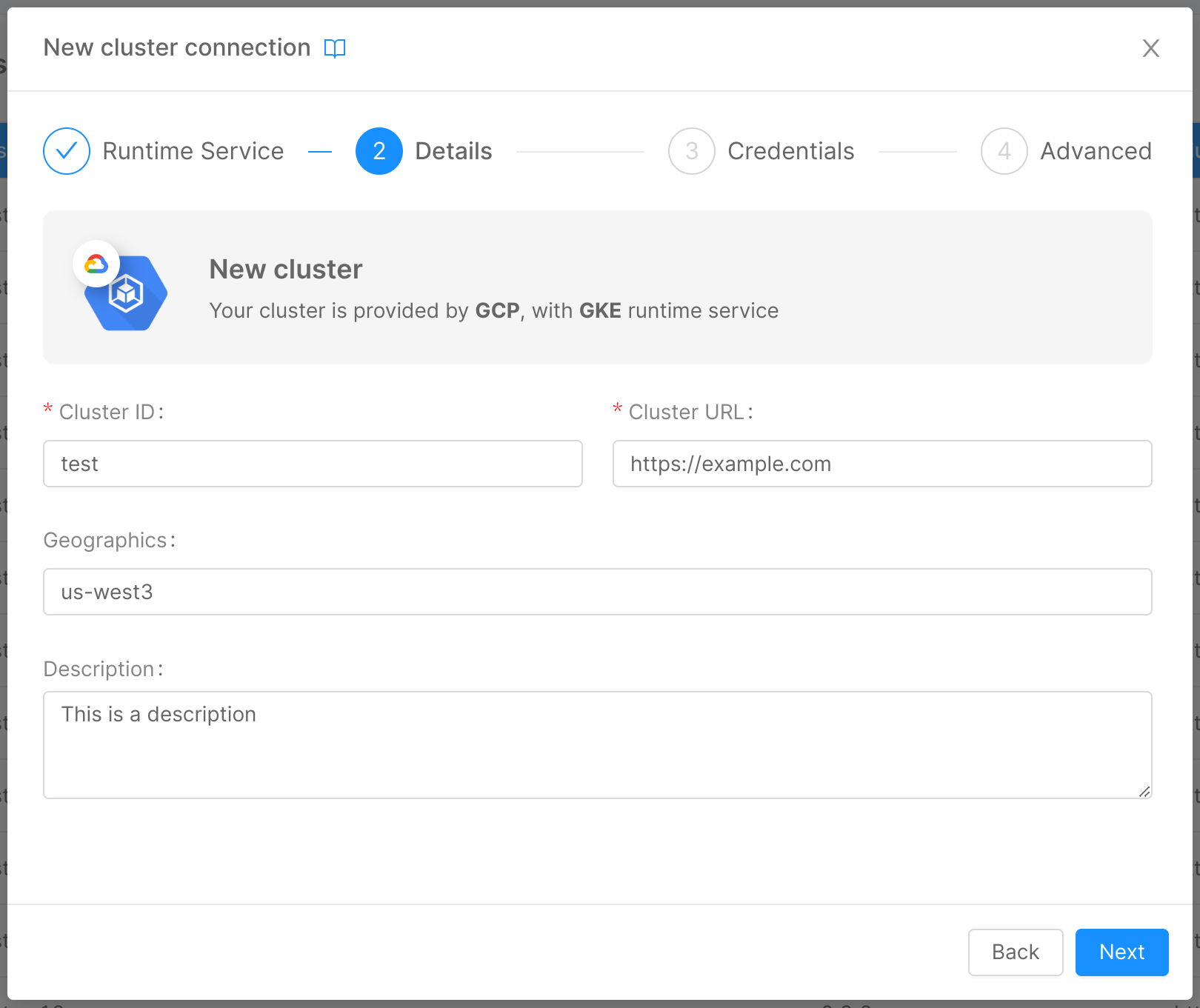
In this step, you can insert some general details about your cluster:
- Cluster ID (required): friendly identifier of the cluster, assigned by the user while connecting the cluster to the Console;
- Cluster URL (required): URL used to connect to the cluster, which indicates where the cluster is exposed;
- Geographics: a label used to describe the location of the cluster;
- Description: a brief description of the cluster.
Step 3: Credentials
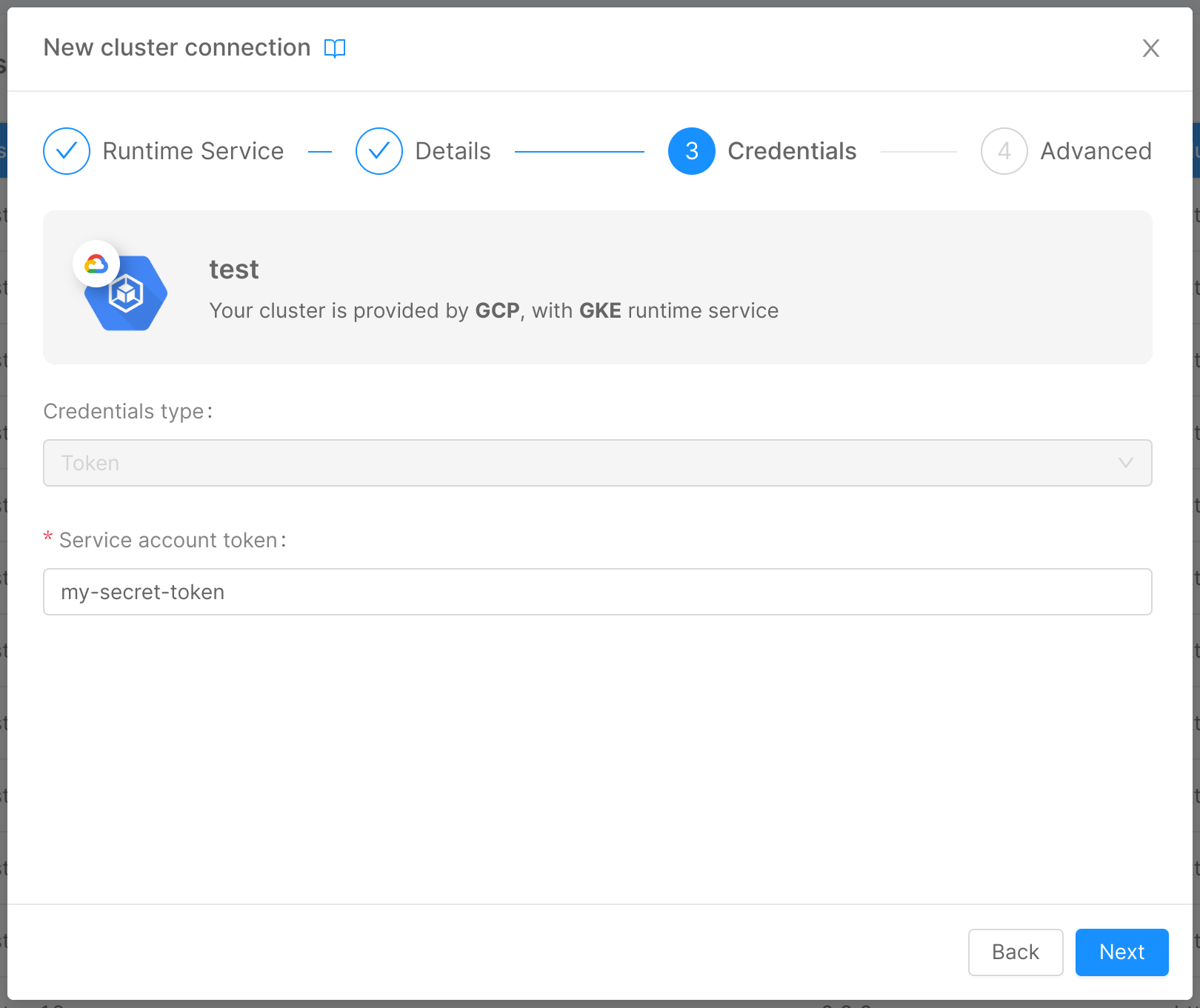
In this step, you are required to insert some information about the cluster credentials:
Credentials Type (required): the type of credentials used to authenticate requests to the cluster. It can be one of "Token," "Client credentials," and "Client credentials certificate".
Depending on the credentials type, the other information to be entered will be the following
- Token
- Client credentials
- Client credentials certificate
For credentials of the type "Token":
- Service account token (required): JWT token needed by the service account to perform operations on the cluster. To extract it, refer to this paragraph.
For credentials of the type "Client credentials":
- Access token URL (required): the reference OAuth2 authorization endpoint URL that, to requests that include client ID and client secret, responds by generating temporary credentials;
- Client ID (required): OAuth2 public client identifier;
- Client secret (required): OAuth2 secret, known only to the client and the authorization server;
- Scope: permission set used to grant access to specific resource functionalities. In other words, a scope represents what an application can access on behalf of the user.
For credentials of the type "Client credentials certificate":
- Access token URL (required): the reference OAuth2 authorization endpoint URL that, to requests that include client ID and client secret, responds by generating temporary credentials;
- Client ID (required): OAuth2 public client identifier;
- Private key (required): private key of the client certificate used as an authentication token to sign a JWT assertion (in PEM format);
- Certificate thumbprint (required): hash of the certificate, computed over all certificate data and its signature, used as a unique identifier for the certificate itself;
- Scope: permission set used to grant access to specific resource functionalities. In other words, a scope represents what an application can access on behalf of the user.
All credentials data are stored in an encrypted MongoDB collection. For more information about MongoDB encryption, take a look at the dedicated documentation page.
Credentials entered at this stage, for security reasons, will never again be shown to the user, who will be able to replace them with new ones but not visualize them again.
Supported credential types
Depending on the vendor and runtime service selected in step 1, the types of credentials supported will change. The following table shows the credential types supported by each runtime service:
| Vendor | Runtime Service | Credentials Type |
|---|---|---|
| Google Cloud Platform (GCP) | Google Kubernetes Engine (GKE) | Token |
| GKE Autopilot | Token | |
| Amazon Web Services (AWS) | Elastic Kubernetes Service (EKS) | Token |
| EKS Fargate | Token | |
| Microsoft Azure | Azure Kubernetes Service (AKS) | Token, Client credentials, Client credentials certificate |
| Oracle Cloud | Oracle Container Engine for Kubernetes (OKE) | Token |
Azure gives the user the possibility to create new app registrations while defining access to resources. For the purpose of connecting the cluster to the Console it is important to know "Application (client) ID" and "Directory (tenant) ID", displayed at the end of the process. After the registration process, the user can add their credentials to Azure, choosing either to set a client secret (in which case the credentials type will be "Client credentials") or to upload a certificate (in which case it will be "Client credentials certificate" instead).
Useful links (Azure documentation):
The values to be entered at creation will then be:
- Access Token URL:
https://login.microsoftonline.com/{tenant}/oauth2/v2.0/token, where{tenant}is the value of "Directory (tenant) ID" (in case you are using the public instance of AKS); - Client ID: the value of "Application (client) ID";
- Scope: the value of the "Application ID" of the Azure Kubernetes Service AAD Server application +
/.default. So, for example if the Azure Kubernetes Service AAD Server ismy-client-id, the scope will bemy-client-id/.default, without the protocol. The Azure Kubernetes Service AAD Server application is showed on Azure as an external application and it is automatically created by Azure itself:

- Client credentials
- Client credentials certificate
If the credentials type is "Client credentials":
- Client secret: the value of the client secret set.
If the credentials type is "Client credentials certificate":
- Private key: the private key of the certificate uploaded;
- Certificate thumbprint: the thumbprint associated with the certificate uploaded, it is the Base64url-encoded SHA-1 thumbprint of the certificate itself. As specified in the official documentation of the
x5tfield.
Step 4: Advanced
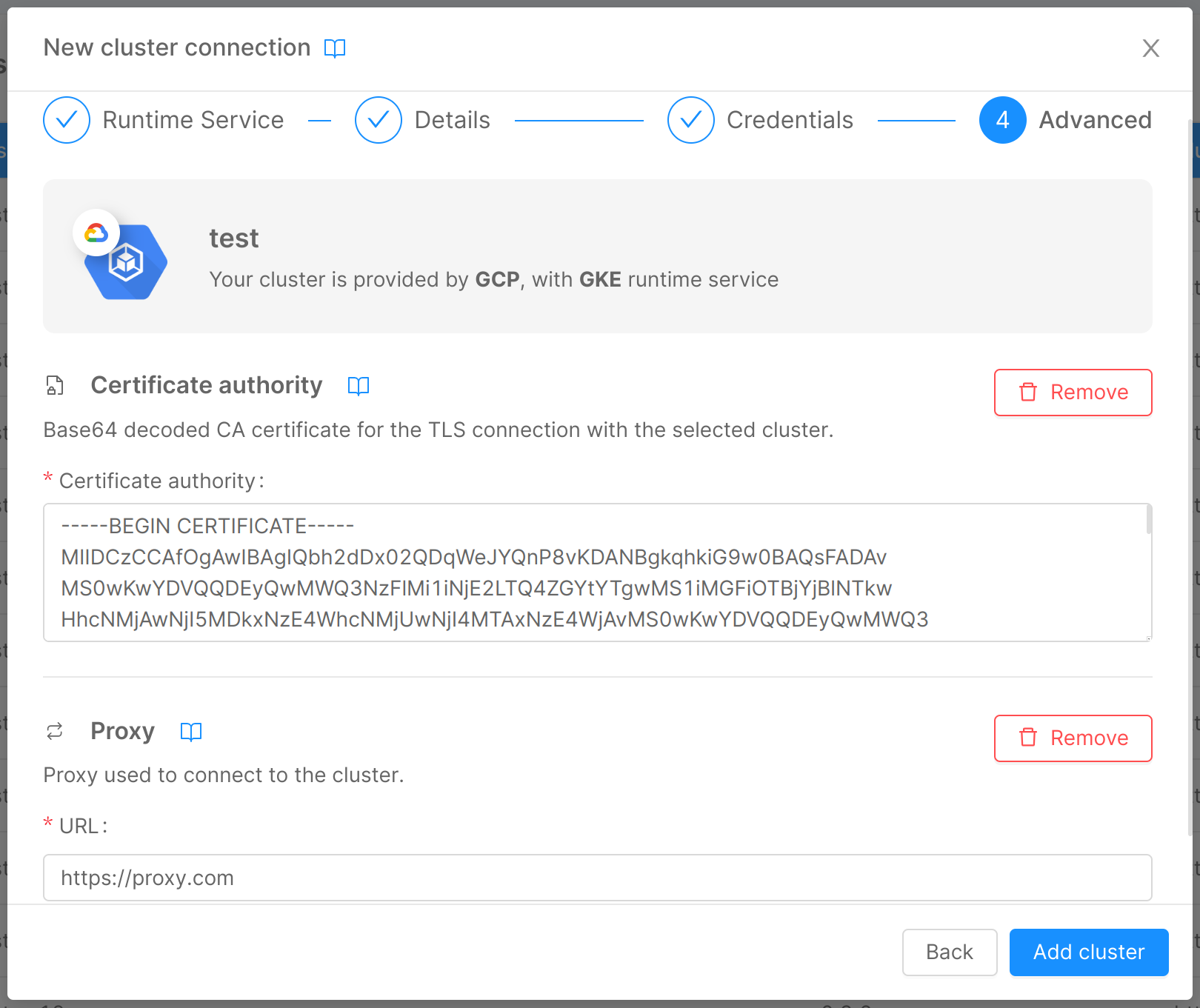
In this step, you can insert some advanced information about the cluster:
- Certificate authority: CA certificate for the TLS connection with the cluster. To extract it, refer to this paragraph;
- Proxy URL: URL of the proxy used to connect to the cluster, usually needed when the cluster is exposed on a private network.
By clicking on "Add cluster", the connection to the cluster will be set, and it will appear as a new entry in the table.
A syntactic check is performed at the moment of data entry, but the Console will verify their correctness on saving, contacting the cluster to establish the connection. Therefore, inserting a wrong URL, token, or certificate will result in a network error because the cluster will not be contacted successfully, and thus it will not be connected nor saved.
In case the service account is not configured on the specific cluster, upon creation of an environment associated with that cluster the Console will not be able to generate the token needed for deployment. More information on how to connect the service account can be found here.
View Cluster Information
By clicking on the arrow button located in the rightmost column of a cluster entry in the table, a new page will show up, displaying information about the specific cluster through a few cards:
- Details: this card shows the information inserted by the user when connecting the cluster to the Console, and allows to modify this information through the "Edit" button in the top right corner, as further explained below.

- Credentials: this card shows the cluster credentials type, and allows to replace cluster credentials through the "Change credentials" button in the top right corner, as further explained below.

- Runtime information: this card shows the runtime information of the cluster, taken by aggregating data from the machines on which the cluster is hosted. More specifically:
- Kubernetes version: Git version of the Kubernetes master node associated with the cluster;
- RAM: the total amount of RAM used by the machines (in MiB);
- CPU: the total amount of CPU used by the machines (in terms of number of cores);
- Nodes: number of nodes associated with the cluster.

- Utilization: this card simply shows the environments installed on the cluster, and the projects associated with these environments. A search bar allows you to quickly find the project you are looking for, filtering the data in the table.
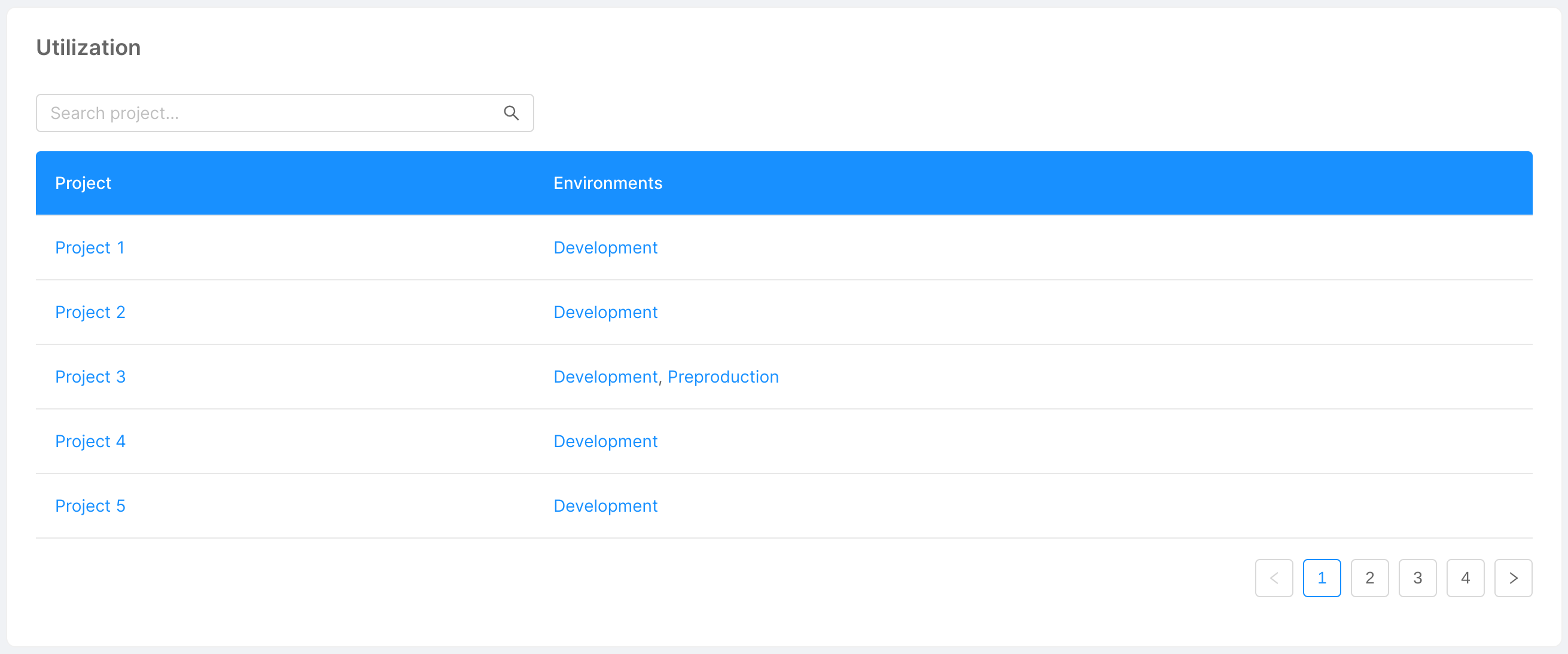
- Advanced: this card shows the advanced cluster information inserted by the user when connecting the cluster to the Console. It is divided into 2 tabs: "Certificate Authority" and "Proxy", each of which displays the related information. The "Edit" button in top right corner allows opens a modal identical to the one shown in the step 4 of cluster connection, and allows the user to remove or modify this information, as further explained below.


Clicking on the "View certificate" button allows the user to visualize the base64 CA certificate in both human-readable and plain versions in a two-tabs modal. The "Expanded view" tab displays the human-readable version of the certificate, while the "Text view" tab shows its plain version, and a copy button in the modal footer allows the user to quickly copy the plain base64 CA certificate.

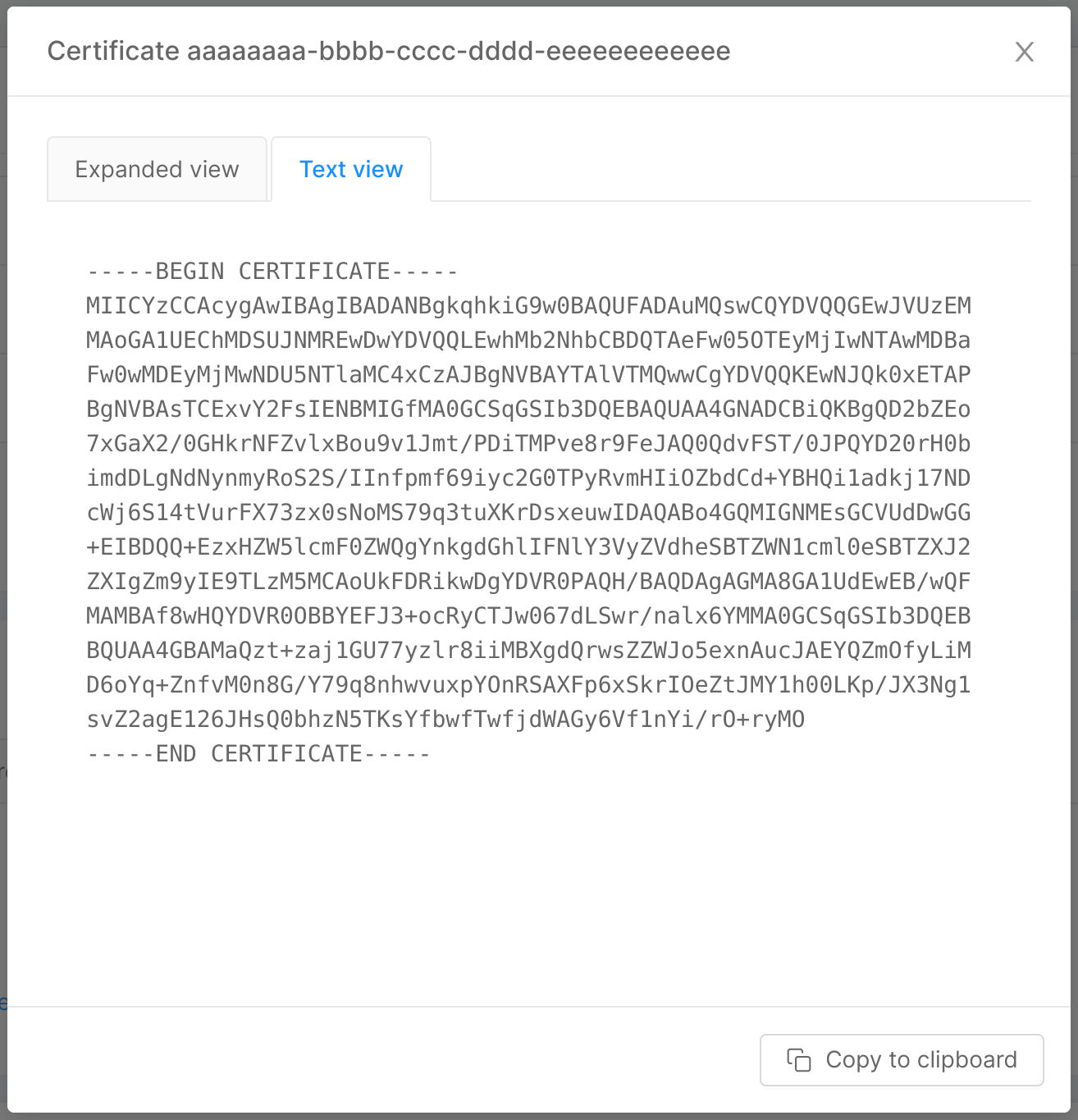
Edit a Cluster Connection
As mentioned in the previous section, it is possible to modify (most of) the information inserted by the user while connecting the cluster to the Console. To do this, you can use the appropriate "Edit" buttons in the top right corner of the cards (for credentials, being a real replacement rather than a modification of the existing ones, the button is called "Change credentials").
A click on the button opens a modal very similar to the one seen when connecting the cluster, specific for the information to modify. For example, clicking on "Edit" button of the "Details" card will display the modal below. By clicking on "Edit cluster" (or "Change credentials" in the case of credentials), the connection to the cluster will be updated.
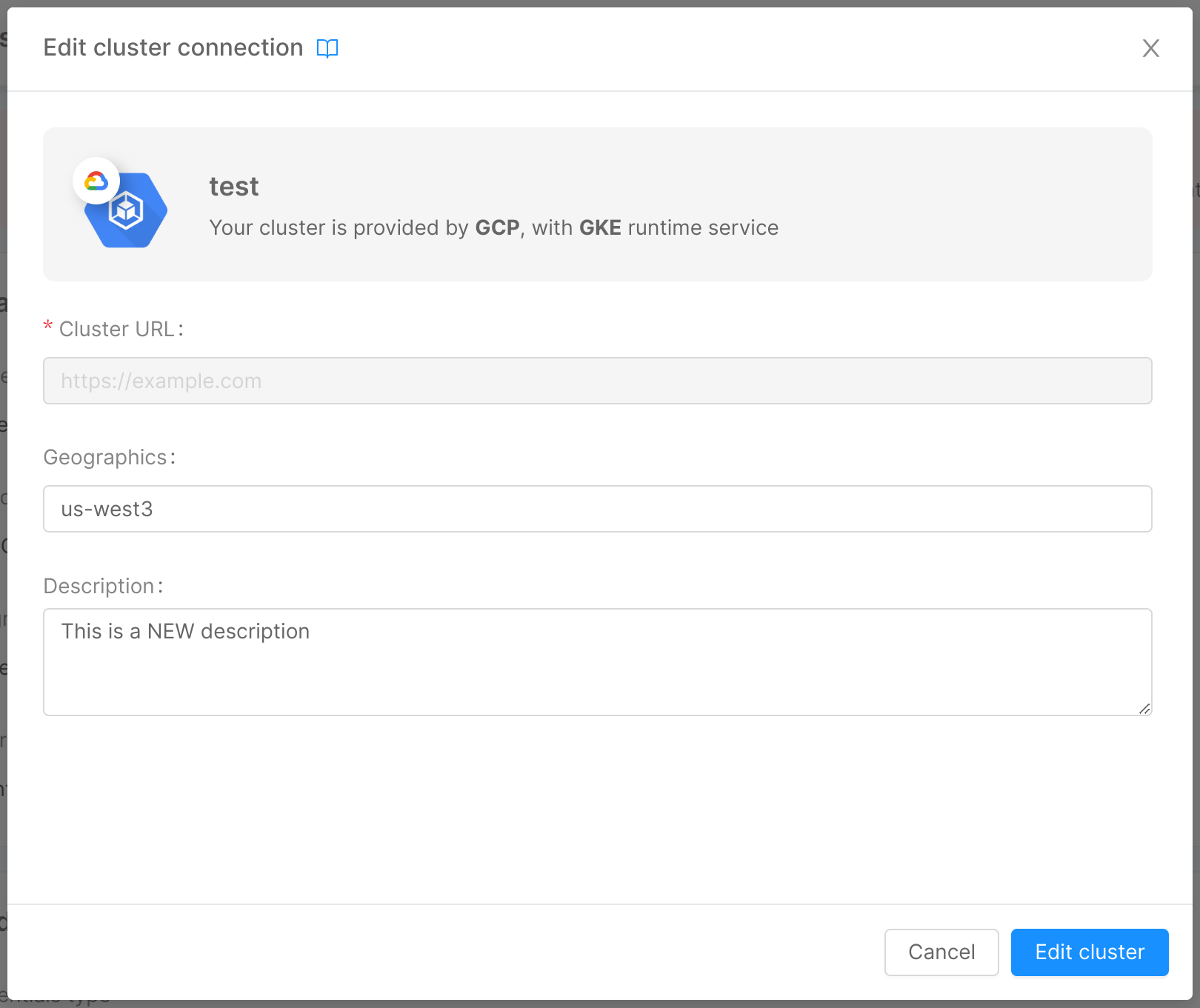
Remove a Cluster Connection
In the bottom part of the page, there is a footer which allows you to remove the cluster connection from the Console. By clicking on the "Remove" button, a modal will be displayed, asking for confirmation of the removal.
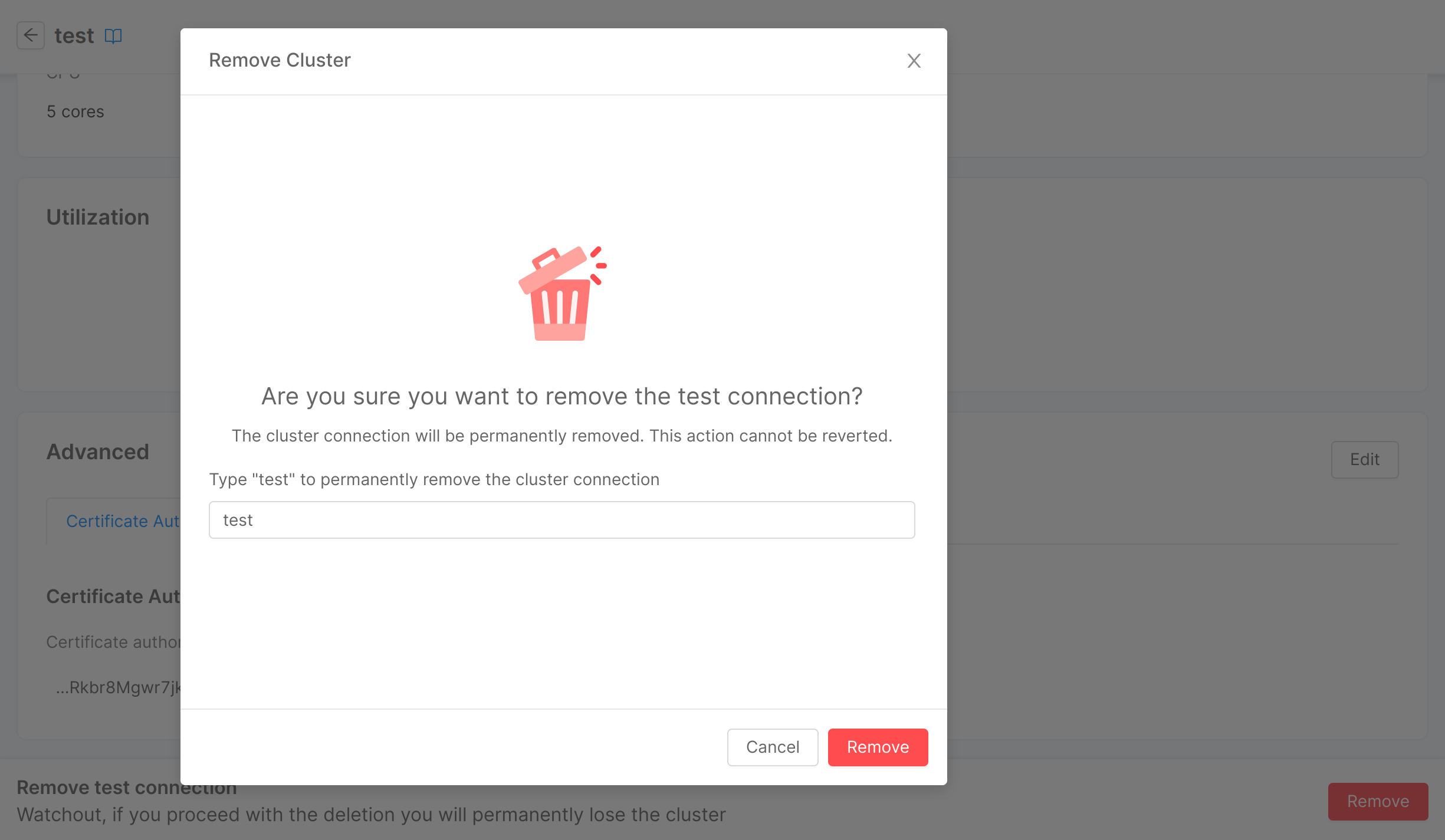
After entering the name in the input field and clicking "Remove", a loading and finally a feedback of successful removal will be shown. Closing the modal will then redirect you to the clusters table. In case of errors, an informative feedback will be shown instead, and the "Close" button will not perform any redirection.
Removing a cluster connection is only possible if the cluster has no connected environment.